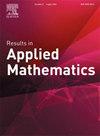(2+1)-dimensional discrete exterior discretization of a general wave model in Minkowski spacetime
IF 1.4
Q2 MATHEMATICS, APPLIED
引用次数: 0
Abstract
We present a differential geometry-based model for linear wave equations in -dimensional spacetime. This model encompasses acoustic, elastic, and electromagnetic waves and is also applicable in quantum mechanical simulations. For discretization, we introduce a spacetime extension of discrete exterior calculus, resulting in a leapfrog-style time evolution. The scheme further supports numerical simulations of moving and deforming domains. The numerical tests presented in this paper demonstrate the method’s stability limits and computational efficiency.
闵可夫斯基时空中一般波模型的(2+1)维离散外离散化
我们提出了一个基于微分几何的(2+1)维时空线性波动方程模型。该模型包括声波、弹性波和电磁波,也适用于量子力学模拟。对于离散化,我们引入了离散外演算的时空扩展,得到了一个跨越式的时间演化。该方案进一步支持移动和变形区域的数值模拟。文中的数值试验证明了该方法的稳定性、局限性和计算效率。
本文章由计算机程序翻译,如有差异,请以英文原文为准。
求助全文
约1分钟内获得全文
求助全文
来源期刊

Results in Applied Mathematics
Mathematics-Applied Mathematics
CiteScore
3.20
自引率
10.00%
发文量
50
审稿时长
23 days
 求助内容:
求助内容: 应助结果提醒方式:
应助结果提醒方式:


